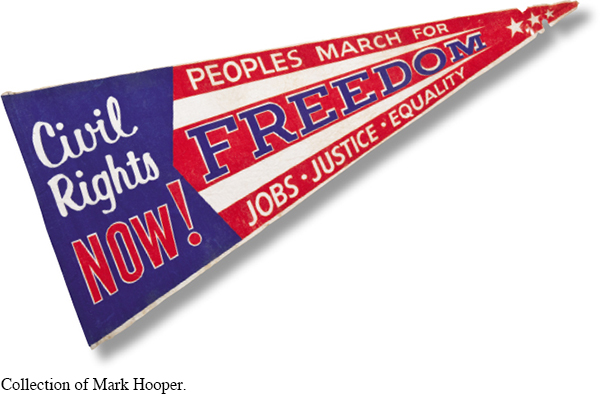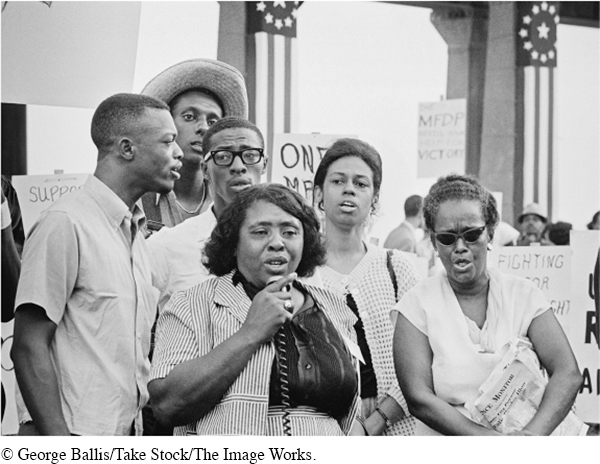The American Promise: Printed Page 801
The American Promise, Value Edition: Printed Page 725
The American Promise: A Concise History: Printed Page 828
Introduction to Chapter 28
The American Promise: Printed Page 801
The American Promise, Value Edition: Printed Page 725
The American Promise: A Concise History: Printed Page 828
Page 80128
Reform, Rebellion, and Reaction
1960–

CONTENT LEARNING OBJECTIVES
After reading and studying this chapter, you should be able to:
Identify the ways in which liberalism was manifested in President Johnson’s Great Society.
Identify the strategies civil rights activists used during the 1960s and describe Washington’s response. Explain the rise of the black power movement and its influence on American society.
Explain how the civil rights movement inspired protest movements among other groups, including Native Americans, Chicanos, students, and gays and lesbians.
Define the origins of the feminist movement and identify its various strategies and criticisms of society. Explain feminism’s achievements and the backlash it provoked.
Describe the ways in which liberalism persisted during the Nixon administration.
ON AUGUST 31, 1962, FORTY-
At the Indianola County courthouse, Hamer passed through a hostile, white, gun-
The American Promise: Printed Page 801
The American Promise, Value Edition: Printed Page 725
The American Promise: A Concise History: Printed Page 828
Page 802Fannie Lou Hamer’s courage and determination made her a prominent figure in the black freedom struggle, which shook the nation’s conscience, provided a protest model for other groups, and pressured the government. After John F. Kennedy was assassinated in November 1963, Lyndon B. Johnson launched the Great Society—
Yet strong civil rights legislation and pathbreaking Supreme Court decisions could not alone mitigate the deplorable economic conditions of African Americans nationwide, on which Hamer and others increasingly focused after 1965. Nor were liberal politicians reliable supporters, as Hamer found out in 1964 when President Johnson’s allies rebuffed black Mississippi Democrats’ efforts to be represented at the Democratic National Convention. By 1966, a minority of African American activists were demanding black power; the movement soon splintered, while white support sharply declined. The war in Vietnam stifled liberal reform, while a growing conservative movement denounced the challenge to American traditions and institutions mounted by blacks, students, and others.

Though disillusioned and often frustrated, Fannie Lou Hamer remained an activist until her death in 1977, participating in new social movements stimulated by the black freedom struggle. In 1969, she supported students at Mississippi Valley State College who demanded black studies courses and a voice in campus decisions. In 1972, she attended the first conference of the National Women’s Political Caucus, established to challenge sex discrimination in politics and government.
Feminists and other groups, including ethnic minorities, environmentalists, and gays and lesbians, carried the tide of reform into the 1970s. They pushed Richard M. Nixon’s Republican administration to sustain the liberalism of the 1960s, with its emphasis on a strong government role in regulating the economy, guaranteeing the welfare and rights of all individuals, and improving the quality of life. Despite its conservative rhetoric, the Nixon administration implemented affirmative action and adopted innovative measures in environmental regulation, equality for women, and justice for Native Americans. The years between 1960 and 1974 witnessed the greatest efforts to reconcile America’s promise with reality since the New Deal.
CHRONOLOGY
| 1960 |
|
| 1961 |
|
| 1962 |
|
| 1963 |
|
| 1964 |
|
| 1964– |
|
| 1965 |
|
| 1965– |
|
| 1966 |
|
| 1967 |
|
| 1968 |
|
| 1969 |
|
| 1970 |
|
| 1972 |
|
| 1973 |
|